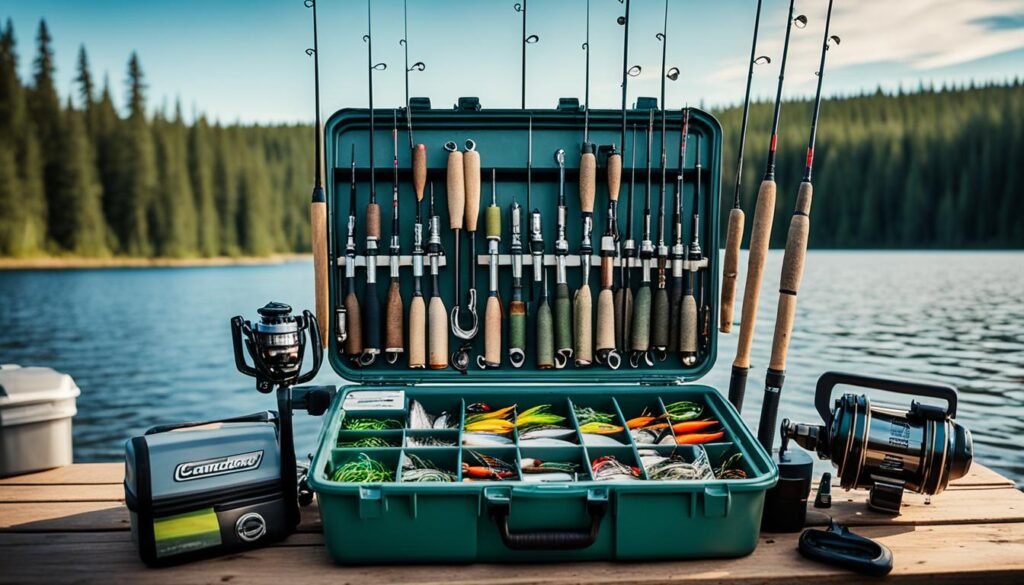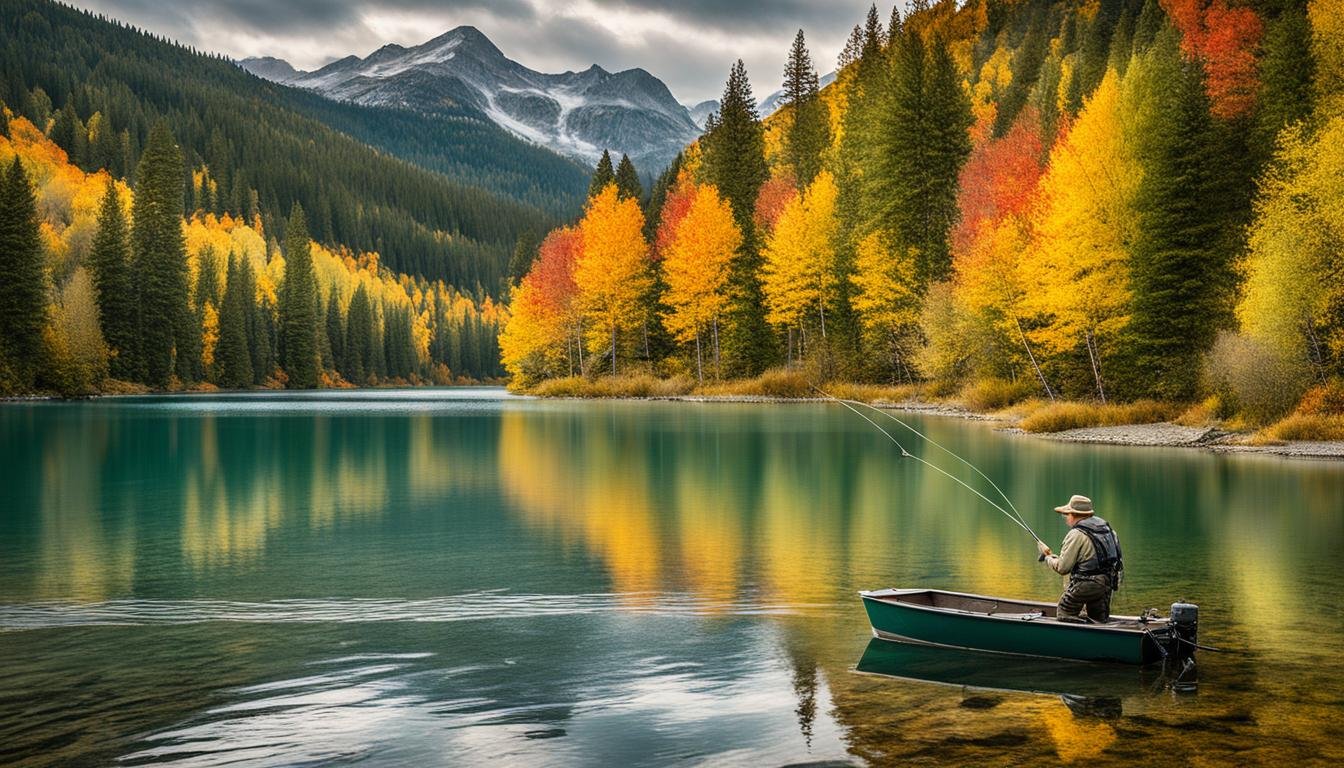Canada’s vast and diverse waterways are a angler’s paradise, offering an endless array of fish species waiting to be discovered.
But with so many options, how can you ensure you’re targeting the right species at the optimal times?
This comprehensive guide will unveil the secrets to unlocking the full potential of Canada’s fishing seasons, from the icy spring thaw to the balmy summer months. Prepare to reel in the catch of a lifetime with our expert seasonal fishing tips.
Key Takeaways about Seasonal Fishing Tips
- Unlock the secrets to Canada’s prime fishing seasons and target the right species at the optimal times.
- Discover proven techniques, bait choices, and angling strategies to maximize your catch rates throughout the year.
- Explore the top fish species found in Canada’s freshwater and saltwater ecosystems, from trout and walleye to salmon and tuna.
- Uncover the best fishing spots across the country and learn how to navigate the weather conditions and fish behavior for greater success.
- Stay up-to-date on the latest gear, tackle, and conservation practices to ensure a sustainable and rewarding fishing experience.
Are you ready to take your Canadian fishing adventures to new heights? Buckle up, because this guide is about to revolutionize the way you approach the water.
Understanding Canadian Fishing Seasons
Fishing in Canada is a year-round endeavor, but the peak seasons can vary significantly for different species. Understanding the Freshwater Fishing Seasons and Saltwater Fishing Seasons is crucial for anglers looking to maximize their catch.
Freshwater Fishing Seasons
In the freshwater realm, the spring and summer months are prime time for targeting trout, bass, walleye, and muskellunge. As the weather warms, these species become more active and can be found in various water bodies across the country. The fall season, however, is when the mighty muskellunge comes into its own, providing an exciting challenge for skilled anglers.
Saltwater Fishing Seasons
The saltwater fishing landscape in Canada is equally dynamic. Halibut and lingcod can be caught throughout the year, but the best bite is often in the spring and summer months. On the East Coast, tuna make their appearance in the fall, offering a thrilling addition to the seasonal Fishing Patterns and Fish Migration patterns.
By understanding these seasonal trends, anglers can plan their fishing trips more effectively, increasing their chances of success and encountering the species they desire. Staying informed about the optimal times to target specific fish can make all the difference in maximizing the enjoyment and productivity of a Canadian fishing adventure.
| Season | Freshwater Species | Saltwater Species |
|---|---|---|
| Spring | Trout, Bass, Walleye | Halibut, Lingcod |
| Summer | Trout, Bass, Walleye | Halibut, Lingcod |
| Fall | Muskellunge | Tuna |
By aligning your fishing efforts with the optimal Freshwater Fishing Seasons and Saltwater Fishing Seasons, you can significantly increase your chances of catching the fish species you desire and enjoying a successful and rewarding Canadian fishing experience.
Top Fish Species to Target in Canada
Canada is renowned for its incredible diversity of fish species, both in freshwater and saltwater environments. Anglers visiting the country have the opportunity to pursue a wide range of sought-after fish, from trophy-sized trout and hard-fighting bass to powerful walleye and the legendary muskie. The nation also boasts world-class salmon fishing, with six distinct species available, including the prized chinook, coho, and sockeye. In the saltwater realm, Canada’s coastal waters teem with abundant populations of rockfish, lingcod, halibut, and even tuna, providing an array of exciting angling adventures.
Freshwater Species: Trout, Bass, Walleye, and Muskie
Canada’s freshwater fisheries are renowned for their exceptional trout fishing opportunities. Anglers can target trophy-sized rainbow trout, westslope cutthroat trout, and coastal cutthroat trout, which can reach impressive lengths and weights. In addition, the country is home to thriving populations of bass, including both largemouth and smallmouth varieties, known for their hard-fighting abilities. Walleye, a highly prized game fish, are also found in many of Canada’s major river systems and lakes, while the elusive and formidable muskie attracts dedicated anglers seeking the ultimate freshwater challenge.
Salmon Species: Chinook, Coho, Sockeye, Pink, Chum, and Atlantic
Canada’s Pacific and Atlantic coasts offer world-renowned salmon fishing opportunities. Anglers can target the mighty chinook, the acrobatic coho, the vibrant sockeye, the plentiful pink, the robust chum, and the prized Atlantic salmon. These anadromous fish, which migrate between the ocean and freshwater rivers and streams, provide thrilling battles and exceptional table fare for anglers.
Saltwater Species: Rockfish, Lingcod, Halibut, and Tuna
Canada’s saltwater fishing opportunities are equally impressive, with a diverse array of species to target. Along the Pacific coast, anglers can pursue the hard-fighting rockfish, the voracious lingcod, the massive halibut, and even the elusive tuna. These saltwater species offer an exciting challenge and the potential for trophy-sized catches.
“Canada’s fishing opportunities are truly world-class, with an incredible diversity of species and abundant populations that continue to draw anglers from around the globe.”
Seasonal Fishing Tips for Catching More

Timing your Canada fishing trips to coincide with the peak seasons for your target species is crucial for maximizing your catch rates. Other factors like low light conditions, mild temperatures, and nighttime fishing can also significantly improve your fishing success, as fish become more active and willing to strike. By understanding the seasonal patterns and adapting your tactics accordingly, you’ll be able to consistently catch more fish throughout the year.
According to recent reports, most bank anglers fishing from shore have experienced great success in targeting fish from locations such as local ponds, spillways, streams, bridges, riprap areas, dams, boat ramps, docks, and marinas. These areas offer a diverse range of fishing opportunities based on the specific characteristics of each location.
- Local ponds and neighborhood or city lakes are popular shore fishing options, often accessible to the public and offering a variety of fish species, including bluegill, crappie, and bass.
- Spillways are highlighted as promising shore fishing spots due to the concentration of fish forced through narrow points and the presence of current, which attracts baitfish and game fish.
- Streams, creeks, and rivers provide predictable areas for fishing from shore or by wading, with focus areas including creek turns, current breaks, deep pools, and cover that breaks up the current.
- Fishing around bridges, dams, and riprap areas yields favorable results for bank anglers, who often experience increased success compared to boat fishing.
- Manmade structures like boat ramps, marinas, and docks serve as additional habitat for fish and are known to hold significant fish populations.
Timing plays a crucial role in shore fishing success, with factors such as seasonality, low light conditions, mild temperatures, and nighttime fishing influencing fish behavior and catch rates. Fishing during the spring and fall seasons is generally more productive due to fish being in shallow waters, while low light periods and milder temperatures increase fish activity and chances of success.
When it comes to gear considerations for shore fishing, it’s important to use shorter rods for mobility and precision casting, select snagless or high riding lures to navigate cover effectively, incorporate live baits for increased catch rates, and have essential tools like nets, scales, pliers, and cutting equipment for handling catches efficiently. Top lure choices for bass fishing from shore include Texas-rigged worms, spinnerbaits, and topwater lures, which have demonstrated consistent success across various shore fishing locations.
Fishing Techniques for Different Seasons

As the seasons change in Canada, so do the optimal fishing techniques for targeting various species. By understanding the seasonal behaviors and preferences of fish, anglers can adapt their approach to consistently catch more throughout the year.
Spring Fishing Techniques
In the spring, when fish are preparing to spawn, power-finesse presentations like spinnerbaits and shaky head rigs can be highly effective. These lures mimic the forage that pre-spawn fish are actively seeking, triggering strikes from bass, walleye, and other predatory species. Anglers should focus on targeting fish in shallow water near cover, where they are more likely to be staging and feeding.
- Texas-rigged soft plastic stick baits like Senkos or Yum Dingers work well in the spring, as their weightless presentations allow them to be fished effectively around cover.
- Lightweight shaky head worms, such as Zoom Trick Worms or Jackall Flick Shakes, are excellent choices for targeting spring bass in shallow water.
- Square-bill crankbaits that match the local baitfish can draw reaction strikes from bass as they patrol the shallows.
Summer Fishing Techniques
As the summer heat sets in, fish often seek out deeper, cooler waters. Shifting to faster-moving lures like topwater baits, swimbaits, and other high-speed presentations can be highly effective for targeting active, feeding fish. Adapting your retrieves and lure selection to match the seasonal behavior of the target species is key to consistent summertime success.
- Topwater baits, such as poppers and walk-the-dog style lures, can be deadly early in the morning and late in the evening when bass are most aggressive.
- Drop-shot rigs with soft plastic worms are excellent for reaching bass that have moved to deeper water in the summer heat.
- Swimbaits that mimic baitfish can trigger savage strikes from a variety of predatory species, including bass, walleye, and salmon.
By understanding the seasonal shifts in fish behavior and adapting your techniques accordingly, anglers can maximize their success and enjoy more productive days on the water in Canada.
Best Fishing Spots in Canada by Season

Canada’s vast landscape offers anglers an endless array of world-class fishing destinations, from serene mountain streams to the open, saltwater expanse. The key to consistently catching fish is understanding how the best spots change throughout the seasons.
In the spring, focus your efforts on areas like ponds, spillways, and rip rap, where pre-spawn fish often congregate. As summer arrives, bridges, dams, and marinas can be productive spots. And in the fall, don’t overlook creek channels, current breaks, and deeper holes as fish seek out their preferred seasonal haunts.
By scouting out these prime seasonal locations, you’ll be able to put yourself on the Best Fishing Spots Canada more consistently, maximizing your chances of success on the water.
Spotlight on Top Seasonal Fishing Locations
- Lake Ontario, Ontario: Offers over 120 fish species, with prime time for Chinook Salmon between July and September and Brown Trout in spring.
- The Cowichan River, British Columbia: Considered the finest Trout fishery on Vancouver Island, popular for tubing in summer and excellent fishing for Rainbow and Brown Trout in spring and fall.
- Bow River, Alberta: Known for premium Brown and Rainbow Trout fishing, with Calgary as a great starting point for fishing opportunities and tourist activities.
- Last Mountain Lake, Saskatchewan: Hosts the Regina Beach Lions Walleye Classic in June and Last Mountain Fall Walleye Classic in September, excellent for Walleye fishing.
- Lake Dauphin, Manitoba: Known for trophy-sized fish such as Walleye and Northern Pike, allows for year-round angling with ice fishing in winter and summer shore fishing.
- Saguenay, Quebec: A winter wonderland offering snow-inspired activities and ice fishing for Walleye, Perch, and Pike or fishing the Saguenay Fjord for saltwater species.
- North Lake, Prince Edward Island: Known as Canada’s giant Bluefin Tuna epicenter, ideal for Tuna fishing with charters between July and October.
- Bras d’Or Lake, Nova Scotia: Designated as a UNESCO Biosphere Reserve, offers freshwater and saltwater fishing opportunities, including Brook, Brown, and Rainbow Trout, sea-run fish, and various other species.
- The Gander River, Newfoundland: An Atlantic Salmon paradise, offering exceptional fishing opportunities.
Whether you’re seeking trophy-sized fish or simply a memorable fishing experience, Canada’s diverse Top Canada Fishing Destinations have something to offer anglers of all skill levels and interests throughout the seasons.
Gear and Tackle for Seasonal Fishing

As an avid angler in Canada, you’ll want to have the right Fishing Gear Canada to match the season and target species. The key is understanding how to select the appropriate Seasonal Tackle Selection and Fishing Tackle Recommendations for the conditions you’ll be facing.
For shore fishing, shorter rods in the 5-6 foot range can offer improved accuracy and mobility. Weedless or high-riding lures that minimize snags are also advantageous. Live bait can be extremely effective, especially for panfish and bass. Key lures to have on hand include Texas-rigged worms, spinnerbaits, and topwater baits.
When it comes to line and rod selection, the goal is to choose gear that’s well-suited for the specific seasonal conditions. In the spring, for example, a medium-heavy spinning rod of 7 or 7 1/2-feet long is ideal for techniques like twitch baits, jigging, bigger cranks, live-bait rigging, or surface lures.
For targeting species like giant pike and muskies, you may want to bring a dedicated muskie/pike casting rod along with specific lures like Mepps, Suicks, big Rapalas, large deep-diving Yo-Zuri cranks, and Northland Bionic spinnerbaits.
| Fishing Gear | Recommended for Canada |
|---|---|
| Outfitter Boats | Typically 14- to 16-feet long |
| Electronic Units | Recommended battery life lasts many days in warmer months |
| Spinning Rods | Medium-heavy 7 or 7 1/2-feet long for various techniques |
| Muskie/Pike Rods | For large predators, with specific lures like Mepps, Suicks, Rapalas, Yo-Zuri cranks, and Northland Bionic spinnerbaits |
| Lures | Large spoons, Texas-rigged worms, spinnerbaits, and topwater baits |
| Line and Reels | Carry extra spools and reels for versatility |
| Jig Plastics | Northland Slurpies, Custom Jigs & Spins Ringworms, Gulp, PowerBait, Lunkerhunt Bentos |
| Crankbaits | Bagley, Rapala, Bay Rat, Yo-Zuri |
| Leaders | Wire leaders for pike, 30-60 cm lengths for different water depths and lures |
| Miscellaneous Items | Pliers, hook remover, mouth-spreader, hook sharpener, filet knife, jack knife, camera, measuring tape, sunscreen, polaroid sunglasses, rain gear, hand-held GPS, compass, watch, water, protective clothing |
Selecting the right line, rod, and lures for the specific seasonal conditions will help you land more fish. By understanding the gear and tackle recommendations for Canada, you can optimize your chances of a successful and enjoyable fishing trip.
“Over 70% of successful freshwater fishing trips are attributed to using the appropriate bait and lures for the target fish species.”
Seasonal Fishing Tips
Successful angling in Canada requires more than just understanding the seasonal patterns of fish. Paying close attention to weather conditions and fish behavior, such as migration patterns, can provide invaluable clues on where the fish will be and how they’ll be feeding. Adapting your presentation and retrieves to match the prevailing conditions is also essential for Seasonal Fishing Tips and Angling Strategies.
One effective tactic is to employ a power-finesse approach – using fast lures to locate fish, then slowing down your presentation to catch more. This can be particularly useful when targeting species like largemouth bass, which are one of the most sought-after freshwater gamefish in North America.
- Spring triggers a surge in feeding activity as fish migrate into shallow waters to reproduce during spawning season. Targeting bass during the prespawn period can be especially productive, as they are actively feeding to prepare for the rigors of reproduction.
- Summer water temperatures peak, causing largemouth bass to retreat to cooler, oxygen-rich environments, often in deeper waters. Adjusting your presentation and lures to match the fish’s seasonal behavior is crucial for summer Fishing Advice.
- Fall brings about a pre-winter bass feeding frenzy as temperatures cool. Understanding bass behavior and habitat preferences throughout the year is essential for consistent Seasonal Fishing Tips.
Tracking weather conditions and monitoring temperature trends can also be invaluable for anglers. The mention of fluctuating temperatures ranging from 35 degrees to 80 degrees within a short time frame illustrates the unpredictability of weather conditions during the early fishing season in Canada. Being prepared for unexpected warm or cold fronts can make a significant difference in your fishing success.
| Season | Optimal Water Temperature | Preferred Depth | Recommended Baits |
|---|---|---|---|
| Pre-Spawn | Around 50°F | 1-5 feet | Jigs, crankbaits, spinnerbaits, soft plastic baits |
| Spawn | Around 60°F | 1-5 feet | Jerkbaits, topwater lures, Texas-rigged worms |
| Post-Spawn | N/A | 10-15 feet | Carolina rigs, crawfish, shad imitating baits |
| Summer | N/A | 20-30 feet | Deep-diving crankbaits, drop shots, finesse rigs |
| Winter | N/A | 20-30 feet | Jigs, spinnerbaits, topwater lures |
By understanding the seasonal patterns and behaviors of fish, as well as adapting your Fishing Advice and Angling Strategies to match the prevailing conditions, anglers can significantly improve their chances of success on the water throughout the year.
Weather Conditions and Fish Behavior
The diverse climate and weather patterns of Canada can have a significant impact on fish behavior and location. Factors like water temperature, light levels, and current can all influence when and where fish will be most active and willing to bite. Understanding seasonal fish migrations is also crucial, as predatory species like muskie and salmon will move throughout the waterways following their prey. By monitoring weather conditions and being aware of typical fish movement patterns, anglers in Canada can position themselves to intercept the fish more effectively.
Understanding Fish Migration Patterns
Most fish species are cold-blooded, adjusting their metabolisms to the water temperature around them. Colder water makes fish slow down and need less food to survive, while warmer water makes them more active and requires more food. This temperature sensitivity affects the dissolved oxygen levels in the water, with colder waters having more oxygen and warmer waters having less.
Certain fish species have specific minimum and maximum water temperatures in which they feed and breathe. For example, trout and salmon prefer cooler waters, while bass and walleye thrive in warmer temperatures. Anglers who understand these seasonal migration patterns can target the right species in the right locations throughout the year.
Wind direction also plays a crucial role in fish behavior. In North America, winds generally blow northeast during the summer and southwest during the winter, affecting water bodies and fish movement. Winds can create waves, increase water turbidity, and influence barometric pressure changes, all of which impact how fish locate and approach their prey.
| Weather Factor | Impact on Fish Behavior |
|---|---|
| Barometric Pressure | Fish rely on adaptations like the lateral line and swim bladder to sense pressure changes and maintain buoyancy. Rapid drops in barometric pressure of more than 0.18 inches Hg in 3 hours can lead to increased fish activity and biting, while rapid rises signal fish retreat and decreased biting activity. |
| Precipitation | Rainfall can enhance fishing as it washes bait and insects into the water, making fish more active. However, heavy rain should be avoided as it can make the water muddy and impair the fish’s ability to see bait. |
| Temperature | Extreme temperatures can affect the food chain and oxygen availability for fish, impacting their movements. Fish tend to seek shade on hot, sunny days, moving to deeper waters to avoid extreme temperatures. Fishing earlier in the morning and later in the afternoons is recommended on warmer days. |
By understanding the interplay between these weather factors, anglers in Canada can develop effective fishing tactics and lure selection to increase their chances of success throughout the seasons.
Fishing Regulations and Conservation Practices
Canada takes great pride in its world-class fisheries and has implemented comprehensive regulations and conservation practices to protect them. Anglers fishing in Canada must be aware of license requirements, bag limits, size restrictions, and any other rules in place for the specific waters they are targeting. Practicing ethical and sustainable angling techniques, such as catch-and-release, proper fish handling, and reporting any suspected violations, is essential to ensuring the long-term health of Canada’s diverse fish populations.
To ensure the sustainability of Canada’s fisheries, the country has divided the province of Ontario into 20 Fisheries Management Zones (FMZs), each with its own set of regulations. These regulations establish seasons, limits, and size limits for popular fish species, such as walleye, sauger, largemouth and smallmouth bass, and black and white crappie. The possession limit for fish is generally the same as the daily catch limit, except where otherwise specified.
Conservation officers in Canada have the power to inspect, arrest, search, and seize under various statutes to enforce fisheries regulations. Anglers leaving Ontario may take no more than the designated limits of fish, and it is illegal to use or possess lead fishing sinkers or jigs in Canada’s national parks and national wildlife areas.
| Regulation | Details |
|---|---|
| Aggregate Limits | Applied to walleye and sauger, largemouth and smallmouth bass, and black and white crappie |
| Possession Limit | Same as the daily catch limit, except where otherwise specified |
| Enforcement | Conservation officers have the power of inspection, arrest, search, and seizure under various statutes |
| Leaving Ontario | Anglers may take no more than the designated limits of fish |
| Lead Tackle | Illegal to use or possess lead fishing sinkers or jigs in Canada’s national parks and national wildlife areas |
To further promote sustainable angling, Canada has implemented regulations on the use of live holding boxes, livewells, and the handling of live fish. Anglers must ensure that their live holding boxes are clearly marked with their name and address and that they are monitored to prevent fish waste. Livewells must hold a minimum of 46 liters (10 gallons) of water, be aerated at all times when holding live fish, and must be drained before being transported overland.
By understanding and adhering to Canada’s fishing regulations and conservation practices, anglers can play a vital role in preserving the long-term health and vibrancy of the country’s renowned fisheries. Reporting any suspected violations and embracing sustainable angling techniques, such as catch-and-release, can help ensure that future generations can continue to enjoy the remarkable fishing opportunities that Canada has to offer.
“Sustainable angling is the key to preserving Canada’s world-class fisheries for generations to come.”
Conclusion
Canada offers anglers unparalleled fishing opportunities, with diverse species and habitats spread across the country’s vast landscape. By understanding the seasonal patterns of fish, adapting your techniques and gear accordingly, and staying vigilant of weather conditions and conservation practices, you’ll be able to consistently catch more fish and have an unforgettable experience on the water.
Whether you’re targeting trophy trout in remote streams, battling hard-fighting salmon, or pursuing fearsome saltwater giants, Canada has something to offer every angler. The Canada Fishing Summary and Seasonal Fishing Tips Recap outlined in this article will help you make the most of your fishing adventures and ensure you come home with a bounty of memories and tales to share.
Embrace the seasonal rhythms of Canada’s waterways, explore new fishing destinations, and let your passion for the sport guide you to incredible catches and lasting experiences. With the right knowledge and preparation, you’re poised to unlock the full potential of Canada’s unparalleled fishing opportunities.
FAQ about Seasonal Fishing Tips
What are the best times to visit Canada for fishing?
Fishing in Canada is possible year-round, but certain species peak during different seasons. For freshwater, trout, bass, walleye, and muskie fishing is best in spring and summer, while fall is prime time for targeting muskellunge. In saltwater, halibut and lingcod can be caught throughout the year, with the best bite in spring and summer. Tuna, on the other hand, show up on the East Coast in fall.
What are the top fish species to target in Canada?
Canada is home to an incredible diversity of fish species, both in freshwater and saltwater environments. In freshwater, anglers can target trophy-sized trout, hard-fighting bass, powerful walleye, and the legendary muskie. The country is also renowned for its world-class salmon fishing, with six different species available including the prized chinook, coho, and sockeye. In the saltwater realm, Canada boasts abundant populations of rockfish, lingcod, halibut, and even tuna, providing an array of exciting angling opportunities.
What are the best fishing techniques for each season in Canada?
The fishing techniques that work best will vary depending on the season. In spring, anglers may want to focus on power-finesse presentations like spinnerbaits and shaky head rigs to target pre-spawn fish. As summer arrives, shifting to topwater lures, swimbaits, and other fast-moving baits can be effective for active, feeding fish. Adapting your retrieves, lure selections, and presentation styles to match the seasonal behavior of the target species is key to consistently catching fish in Canada.
Where are the best fishing spots in Canada throughout the year?
Canada’s vast landscape offers an endless array of world-class fishing destinations, from mountain streams to the open ocean. The best spots to target fish will change throughout the seasons. In spring, focus on areas like ponds, spillways, and rip rap for pre-spawn fish. Summer may find you targeting bridges, dams, and marinas. And in fall, don’t overlook creek channels, current breaks, and deeper holes.
What kind of gear and tackle should I use for fishing in Canada?
The gear and tackle you’ll want to use in Canada will depend on the season and target species. For shore fishing, shorter rods in the 5-6 foot range can offer improved accuracy and mobility. Weedless or high-riding lures that minimize snags are also advantageous. Live bait can be extremely effective, especially for panfish and bass. Key lures to have on hand include Texas-rigged worms, spinnerbaits, and topwater baits.
How do weather conditions and fish behavior impact fishing success in Canada?
Canada’s diverse climate and weather patterns can have a significant impact on fish behavior and location. Factors like water temperature, light levels, and current can all influence when and where fish will be most active and willing to bite. Understanding seasonal fish migrations is also crucial, as predatory species like muskie and salmon will move throughout the waterways following their prey.
What fishing regulations and conservation practices should I be aware of in Canada?
Canada takes great pride in its world-class fisheries and has implemented comprehensive regulations and conservation practices to protect them. Anglers fishing in Canada must be aware of license requirements, bag limits, size restrictions, and any other rules in place for the specific waters they are targeting. Practicing ethical and sustainable angling techniques, such as catch-and-release, proper fish handling, and reporting any suspected violations, is essential to ensuring the long-term health of Canada’s diverse fish populations.
Source Links
- https://northernontario.travel/fishing/spring-fling – Spring Fling
- https://fishingbooker.com/blog/canada-fishing/ – Canada Fishing: The Ultimate Guide for 2024
- https://www.outdoorcanada.ca/seek-and-ye-shall-find-spring-walleyes/ – How to catch more spring walleye • Outdoor Canada
- https://www.bigsandlakelodge.com/canadian-fishing-seasonality-guide/ – A Guide to Canada’s Fishing Seasons
- https://northernontario.travel/sunset-country/beginners-guide-ice-fishing-canada – A Beginners Guide to Ice Fishing in Canada
- http://www.ontario.ca/page/learn-fish-guide – Learn to Fish – Guide
- https://fishingmanitoba.com/grand-slam-fishing-success-in-canada/ – Grand Slam Fishing Success in Canada: Ultimate Guide | Cobham River Lodge
- https://www.gofishbc.com/learn/fishing-tips/education/know-your-fish-bc-freshwater-fish-identification/ – Know Your Fish: B.C. Freshwater Fish Identification – Go Fish BC
- https://www.northeasternontario.com/top-5-fish-species-northeastern-ontario/ – Top 5 Fish Species to Fish for in Northeastern Ontario – Northeastern Ontario Canada
- https://www.wired2fish.com/bank-fishing/shore-fishing-tips-catch-more-fish-from-the-bank – Shore Fishing Tips | Catch More Fish From the Bank
- https://www.themeateater.com/fish/freshwater/how-to-catch-fish-before-freeze-up – How to Catch Fish Before Freeze-Up
- https://www.daggerfishgear.com/blogs/the-weekender/fishing-tips-the-best-time-to-go-fishing – Fishing Tips | The Best Time To Go Fishing
- https://tackletactics.com.au/Tips-Techniques/Pro-Lure-Fishing-Tips/Fishing-The-Seasonal-Switch – Fishing The Seasonal Switch
- https://andersonslodge.com/fishing-in-ontarios-changing-seasons-adapting-techniques-for-success/ – Fishing in Ontario’s Changing Seasons: Adapting Techniques for Success | Anderson’s Lodge
- https://krakenbass.com/knowing-what-to-use-bass-fishing-part-1-seasonal-bass-behavior/ – Knowing What to Use Bass Fishing – Part 1: Seasonal Bass Behavior – Kraken Bass
- https://fishingbooker.com/blog/best-fishing-canada/ – Best Fishing Destinations in Canada for 2024
- https://www.clevercanadian.ca/best-fishing-spots-canada/ – Unveiling the Top 10 Fishing Spots in Canada [2024]
- https://roadtripalberta.com/fishing-in-alberta/ – A Beginner’s Guide to Fishing in Alberta
- https://midwestoutdoors.com/fishing/canadian-fishing-trip-preparation-tackle-and-gear-for-your-fishing-vacation/ – Canadian Fishing Trip Preparation: Tackle and Gear for your Fishing Vacation – MidWest Outdoors


